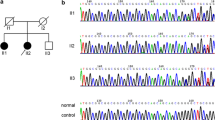Abstract
Oculopharyngeal muscular dystrophy (OPMD) is an autosomal dominant disorder caused by a small expansion of a short polyalanine tract in poly(A) binding protein nuclear 1 (PABPN1). It presents with adult onset of progressive eyelid drooping, swallowing difficulties and proximal limb weakness, usually without involvement of central nervous system (CNS). However, cognitive decline with relevant behavioural and psychological symptoms has been recently described in homozygous patients. In this study, we performed for the first time an extensive neuropsychological and neuropsychiatric evaluation on 11 OPMD heterozygote patients. We found that they were less efficient than a matched control sample on several tests, particularly those tapping executive functions. Moreover, the presence of negative correlation between GCN expansion size and some neuropsychological scores raises the issue that CNS involvement might be linked to the genetic defect, being worse in patients with larger expansion. Our results might be consistent with the toxic gain-of-function theory in the pathogenesis of OPMD and hint at a possible direct role of PABPN1 in the CNS also in heterozygote patients.
Similar content being viewed by others
References
Brais B, Bouchard JP, Xie YG, Rochefort DL, Chrétien N, Tomé FM, Lafrenière RG, Rommens JM, Uyama E, Nohira O, Blumen S, Korczyn AD, Heutink P, Mathieu J, Duranceau A, Codère F, Fardeau M, Rouleau GA (1998) Short GCG expansions in the PABP2 gene cause oculopharyngeal muscular dystrophy. Nat Genet 18:164–167
Brais B, Rouleau GA, Bouchard JP, Fardeau M, Tomé FM (1999) Oculopharyngeal muscular dystrophy. Semin Neurol 19:59–66
Blumen SC, Nisipeanu P, Sadeh M, Asherov A, Tomé FM, Korczyn AD (1993) Clinical features of oculopharyngeal muscular dystrophy among Bukhara Jews. Neuromuscul Disord 3:575–577
Brais B (2009) Oculopharyngeal muscular dystrophy: a polyalanine myopathy. Curr Neurol Neurosci Rep 9:76–82
Blumen SC, Bouchard JP, Brais B, Carasso RL, Paleacu D, Drory VE, Chantal S, Blumen N, Braverman I (2009) Cognitive impairment and reduced life span of oculopharyngeal muscular dystrophy homozygotes. Neurology 73:596–601
Knyrim K, Wagner HJ, Bethge N, Keymling M, Vakil N (1993) A controlled trial of an expansile metal stent for palliation of esophageal obstruction due to inoperable cancer. N Engl J Med 329:1302–1307
Folstein M, Folstein SE, McHugh PR (1975) Mini-mental state: a practical method for grading the cognitive state of patients for the clinicians. J Psychiatr Res 12:189–198
Measso G, Cavarzeran F, Zappalà G, Lebowitz BD, Crook TH, Pirozzolo FJ, Amaducci LA, Massari D, Grigoletto F (1993) The mini-mental state examination: normative study of an Italian random sample. Dev Neuropsychol 9:77–85
Dubois B, Slachevsky A, Litvan I, Pillon B (2000) The FAB: a frontal assessment battery at bedside. Neurology 55:1621–1626
Appollonio I, Leone M, Isella V, Piamarta F, Consoli T, Villa ML, Forapani E, Russo A, Nichelli P (2005) The frontal assessment battery (FAB): normative values in an Italian population sample. Neurol Sci 26:108–116
Spinnler H, Tognoni G (1987) Standardizzazione e taratura italiana di una batteria di test neuropsicologici. Ital J Neurol Sci 6:23–25
Caltagirone C, Gainotti G, Fasullo C, Miceli G (1979) Validity of some neuropsychological test in the assessment of mental deterioration. Acta Psychiatr Scand 60:50–56
Venneri A, Molinari MA, Pentore R, Cotticelli B, Nichelli P, Caffarra P (1993) Shortened stroop color-word test: its application in Alzheimer’s disease. Adv Biosci 87:81–82
Beck AT, Ward CH, Mendelson M, Mock J, Erbaugh J (1961) An inventory for measuring depression. Arch Gen Psychiatry 4:561–571
Cummings JL, Mega M, Gray K, Rosenberg-Thompson S, Carusi DA, Gornbein J (1994) The neuropsychiatric inventory: comprehensive assessment of psychopathology in dementia. Neurology 44:2308–2314
Tekin S, Cummings JL (2002) Frontal-subcortical neuronal circuits and clinical neuropsychiatry: an update. J Psychosom Res 53:647–654
Turner MA, Moran NF, Kopelman MD (2002) Subcortical dementia. Br J Psychiatry 180:148–151
Dion P, Shanmugam V, Gaspar C, Messaed C, Meijer I, Toulouse A, Laganiere J, Roussel J, Rochefort D, Laganiere S, Allen C, Karpati G, Bouchard JP, Brais B, Rouleau GA (2005) Transgenic expression of an expanded (GCG)13 repeat PABPN1 leads to weakness and coordination defects in mice. Neurobiol Dis 18:528–536
Tome FMS, Fardeau M (1980) Nuclear inclusions in oculopharyngeal muscular dystrophy. Acta Neuropath 49:85–87
Calado A, Tomé FM, Brais B, Rouleau GA, Kühn U, Wahle E, Carmo-Fonseca M (2000) Nuclear inclusions in oculopharyngeal muscular dystrophy consist of poly(A) binding protein 2 aggregates which sequester poly(A) RNA. Hum Mol Genet 9:2321–2328
Uyama E, Tsukahara T, Goto K, Kurano Y, Ogawa M, Kim YJ, Uchino M, Arahata K (2000) Nuclear accumulation of expanded PABP2 gene product in oculopharyngeal muscular dystrophy. Muscle Nerve 23:1549–1554
Conflict of interest
None.
Author information
Authors and Affiliations
Corresponding author
Rights and permissions
About this article
Cite this article
Dubbioso, R., Moretta, P., Manganelli, F. et al. Executive functions are impaired in heterozygote patients with oculopharyngeal muscular dystrophy. J Neurol 259, 833–837 (2012). https://doi.org/10.1007/s00415-011-6255-y
Received:
Revised:
Accepted:
Published:
Issue Date:
DOI: https://doi.org/10.1007/s00415-011-6255-y




